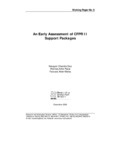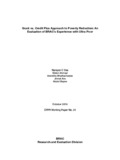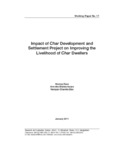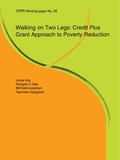Browsing by Author "Das, Narayan Chandra"
Now showing items 1-15 of 15
-
Addressing extreme poverty in a sustainable manner: Evidence from CFPR program
Das, Narayan Chandra; Misha, Farzana A (BRAC Research and Evaluation Division, 2010-06)BRAC initiated an innovative program known as Challenging the Frontiers of Poverty Reduction (CFPR) in 2002 to address the extreme poverty in Bangladesh. Impact assessment studies on the first phase of CFPR (2002-06) have ... -
Can ultra-poverty be sustainably improved? Evidence from BRAC in Bangladesh
Raza, Wameq A.; Das, Narayan Chandra; Misha, Farzana A. (Taylor & Francis, 2012-06-19)With more than one-fifth of Bangladesh's population living in extreme poverty, surmounting it still remains a substantial predicament for development practitioners. To combat this issue, BRAC initiated the multifaceted ... -
Credit and land contracting: A test of the theory of sharecropping
Das, Narayan Chandra; Janvry, Alain de; Sadoulet, Elisabeth (Wiley Online Library, 2019-03-26)Choice of a share vs. fixed rent land rental contract has figured prominently in the theory of industrial organization. This theory tells us that, while a share contract is inefficient in a first-best world, it may be the ... -
An early assessment of CFPR II support packages
Das, Narayan Chandra; Raza, Wameq Azfar; Misha, Farzana Akter (BRAC Research and Evaluation Division, 2009-12)Based on the programmatic lessons and research knowledge accumulated from CFPR phase I, CFPR phase II was designed to expand its outreach while incorporating greater diversity in support packages. The support packages of ... -
“Flypaper effects” in transfers targeted to women: Evidence from BRAC's “Targeting the Ultra Poor” program in Bangladesh
Roy, Shalini; Ara, Jinnat; Das, Narayan Chandra; Quisumbing, Agnes R. (Science Direct, 2015-11)Many development interventions target transfers to women. However, little evidence directly explores the “flypaper effects” of whether women retain control over these transfers once within the household and how reallocation ... -
Grant vs. credit plus approach to poverty reduction: An evaluation of BRAC’s experience with ultra poor
Das, Narayan Chandra; Ahmad, Sibbir; Bhattacharjee, Anindita; Ara, Jinnat; Bayes, Abdul (BRAC Research and Evaluation Division, 2016-10)Challenging the Frontiers of Poverty Reduction- Targeting the Ultra Poor (CFPR-TUP) program of BRAC implements two interventions for the ultra-poor: a grant-based support package for specially targeted ultra-poor (henceforth ... -
How do intra-household dynamics change when assets are transferred to women? Evidence from Brac’s “targeting the ultra poor” program in Bangladesh
Das, Narayan Chandra; Yasmin, Rabeya; Ara, Jinnat; Kamruzzaman, Md.; Davis, Peter; Behrman, Julia A.; Roy, Shalini; Quisumbing, Agnes R. (International Food Policy Research Institute (IFPRI), 2013-12)Growing evidence shows that the distribution of individuals’ ownership and control of assets within a household can have important implications for women’s empowerment and children’s well-being. Interventions that target ... -
How much can asset transfers help the poorest? Evaluating the results of BRAC's ultra-poor programme (2002–2008)
Krishna, Anirudh; Poghosyan, Meri; Das, Narayan Chandra (Taylor and Francis, 2012-02-28)The impacts of an innovative programme in rural Bangladesh, which has assisted extremely poor households, literally the poorest of the poor, were assessed over a six-year period (2002–2008). The provision of a substantial ... -
Impact of char development and settlement project on improving the livelihood of char dwellers
Raza, Wameq; Bhattacharjee, Anindita; Das, Narayan Chandra (BRAC Research and Evaluation Division, 2011-01)The Char Development and Settlement Project (CDSP) was a joint initiative of the Embassy of the Kingdom of the Netherlands and the Government of Bangladesh to achieve sustainable livelihood development of coastal char ... -
Labor markets and poverty in village Economies
Bandiera, Oriana; Burgess, Robin; Das, Narayan Chandra; Gulesci, Selim; Rasul, Imran; Sulaiman, Munshi (Oxford Academic, 2017-03-20)We study how women's choices over labor activities in village economies correlate with poverty and whether enabling the poorest women to take on the activities of their richer counterparts can set them on a sustainable ... -
Livelihood of tea garden laborer: a study on selected tea gardens of Bangladesh
Kairy, Barsha (BRAC University, 2023-05)The main objective of this study was to determine the livelihood adopted by the tea workers in the selected tea gardens. The study was conducted at tea gardens of Sreemangal Upazilla of Moulvibazar districts. Data were ... -
Social protection package for the retrenched workers of state-owned enterprises: A quick assessment
Das, Narayan Chandra; Qayum, Nayma; Khan, Mehejabeen; Karim, Fazlul (BRAC Research and Evaluation Division, 2010-05)BRAC designed and implemented a project namely Kallyan, aiming to improve the quality of life of the retrenched workers of state-owned enterprises of Bangladesh. This study aimed to map the project’s cumulative achievements ... -
Training the disadvantaged youth and labour market outcomes: Evidence from a randomized controlled trial in Bangladesh
Das, Narayan Chandra (BRAC Research and Evaluation Division, 2018-10)This paper estimates the effects of a youth training program in Bangladesh on labour market outcomes. The program provides on-the-job and classroom training to the disadvantaged and unemployed youth. On-the-job training ... -
Ultra poor and asset transfer in Urban setting: Evidence from slums in Bangladesh
Ara, Jinnat; Hossain, Nusrat Zaitun; Das, Narayan Chandra; Bayes, Abdul (Wiley Online Library, 2016-08-09)We use cross-sectional data to assess the impact of the programme on livelihood where propensity score matching technique has been adopted in analysing the data. Results show that programme participants' self-employment, ... -
Walking on two legs: Credit plus grant approach to poverty reduction
Ara, Jinnat; Das, Narayan Chandra; Kamruzzaman, Md; Quayyum, Tasmeen (BRAC Research and Evaluation Division, 2017)There is a growing recognition that the ultra-poor are generally not integrated into the current anti-poverty programs. In this paper, we estimate the long-run impacts of a credit plus grant approach, a combination of ...









